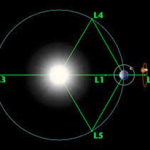The James Webb Space Telescope:
The most powerful space telescope ever made
By Spiros Voros
Have you ever considered what happened 13.7 billion years ago, just 100 million years after the Big Bang? What happened right after the creation of the universe? (Because 100 million years are a tiny fraction of its age). Have you ever thought about the existence of life elsewhere? These are the questions that the James Webb Space Telescope will try to answer.
Being the largest space telescope ever constructed by humanity, the JWST will be able to see back in time. Yes, back in time. According to scientists, space is expanding with a speed greater than the speed of light.
It is also expanding towards all directions. As space expansion is faster than light and distances in space are gigantic, what we see now on Earth while looking at the sky is an image of the past. We just see light that was emitted far away in the past and since then has been travelling to our present via space. Neither time nor space are absolute. Consequently, by looking deep in space, we can see images of the past, images right after the creation. Looking far means shedding light on the past. The power of the JWST will allow us to see the first galaxies and explain many mysteries about them, such as why and how they have supermassive black holes in their centres.
This masterpiece of technology will also be able to analyse the atmospheres of the planets and the stars which it will observe. It is capable of telling us the specific elements that a planet consists of and the exact quantities of each one of them. These data will be then handed to astrobiologists to analyse them in order to determine the possibilities of alien life existence or even confirm it. There are more than 200 research projects already approved on that topic by NASA, ESA and CSA. Humanity is waiting for answers and hopefully the JWST will give them!
As we have already established the purpose of the JWST, it is time to examine its structure. It primarily consists of the main mirror composed of 18 hexagonal segments of gold coated beryllium and it has a diameter of 6.5 meters. The main mirror will reflect and concentrate the light on a smaller one, placed opposite it. Then it will be reflected and concentrated even more on the sensitive optics at the centre of the main mirror. This setup composes the sensor part of the telescope. The second part of the JWST is made to provide stability through space and to protect the super-sensitive and advanced sensor from the heat of the sun. In order for it to work properly, it needs to be cooled down to -223 degrees Celsius, a temperature that can only be achieved if the heat of the sun is dissipated away from it. There are 5, ultra-thin but very durable at the same time, sheets that are capable of doing that. Their size reaches the size of a whole tennis court! They are placed behind the sensor creating a hot and a cold side. The hot side is the one that will face the sun while the cold side is the one that has the JWST sensor. It is the biggest and most powerful space telescope that humans have sent to space. It is so big that it has been launched with an ARIANE 5 space missile folded and it is now undergoing an unfolding process!
But where exactly will it go? Its final place is called Lagrange Point 2(L2). It is 1.5 million kilometers away from the Earth and it is so special because at that exact point all forces (mainly gravitational) cancel each other creating a zero-force equilibrium that will allow the JWST to orbit around the sun while being parallel to the Earth. At this point, it will also be able to be static, in terms of rotation, which will result in having the heat protectors always facing to the sun.
Its mission there is going to last about 10 years according to NASA.
Its development started back in 1996 with a planned launch for 2007. In 2005 there was a major redesign that delayed the plan. A number of several delays, including the COVID-19 pandemic, forced the space agencies to finally launch the telescope on 25th December 2021. Its cost reached the stunning sum of 9.7 billion USD! Its name was chosen in honour of James Edwin Webb, administrator of NASA between 1961 to 1968 who directed many important space missions such as the Apollo Missions.
The James Webb Space Telescope will hopefully provide us with many answers about the universe. In about 30 days from now, the 30th December 2021, we will have the first photo of the telescope. From that historical moment on, researchers will start studying the early universe and will be led to huge discoveries. The upcoming years will be dedicated to science! As time passes, we are going to learn more…
The James Webb Space Telescope
The official mission Post
The main mirror
Lagrange Point 2 (L2)
James Edwin Webb
Sources:
- https://en.wikipedia.org/wiki/James_Webb_Space_Telescope#Background
- https://webb.nasa.gov/content/about/faqs/faqLite.html
- https://en.wikipedia.org/wiki/Lagrange_point
- https://en.wikipedia.org/wiki/James_E._Webb
- https://www.youtube.com/watch?v=73plZTven2Y
- https://www.youtube.com/watch?v=delonLNJacc
- Bιβλίο «Η άνοιξη του σύμπαντος» – Διονύσης Π. Σιμόπουλος – Εκδ.Μεταιχμιο.








